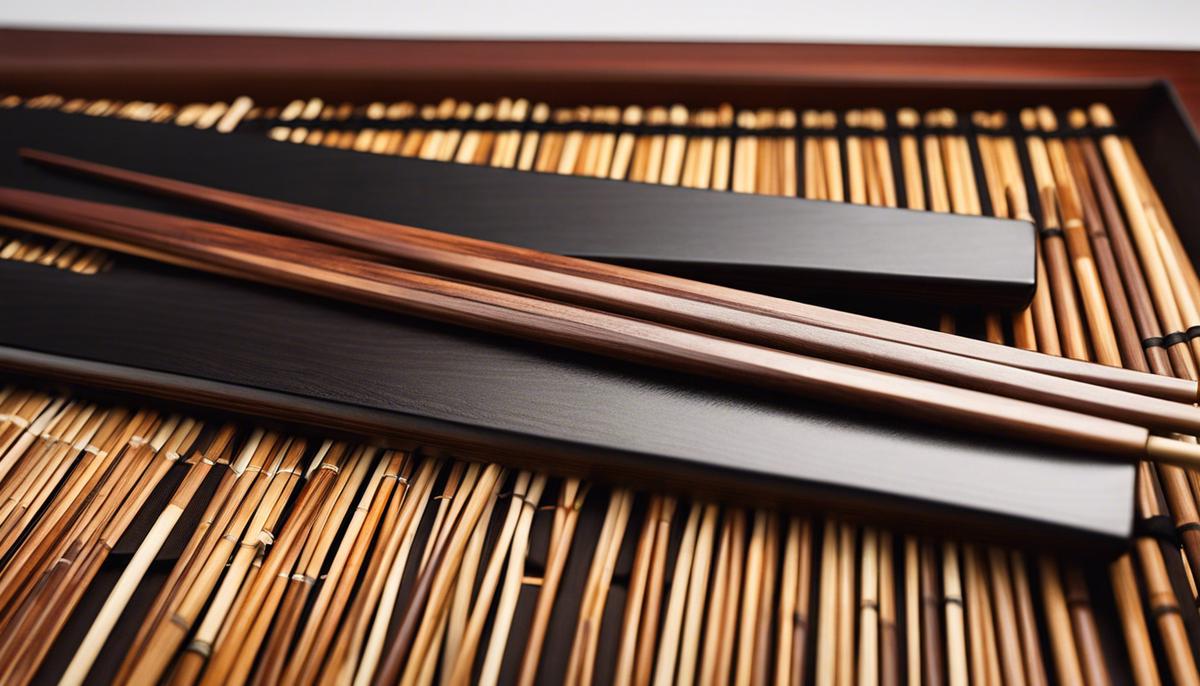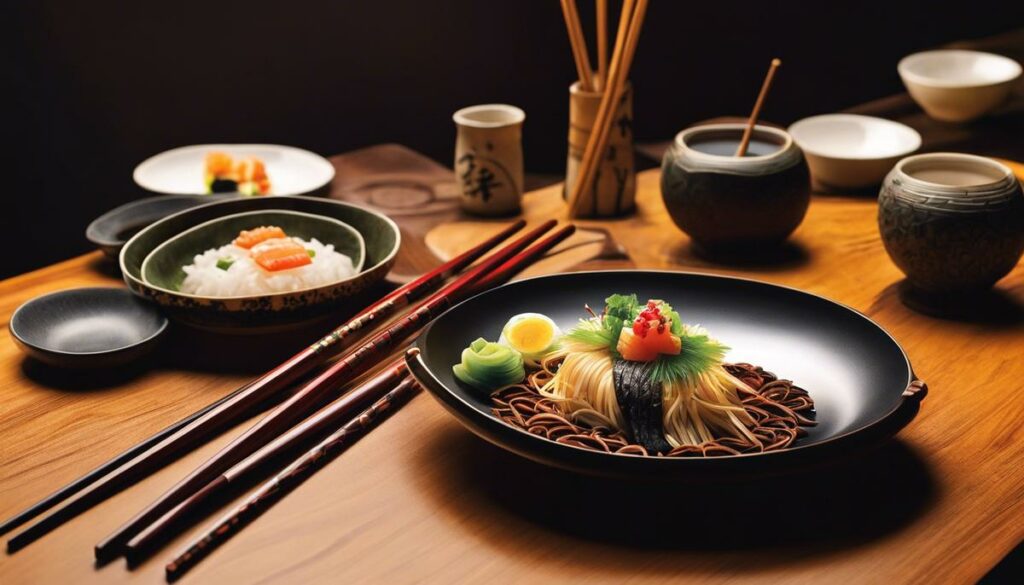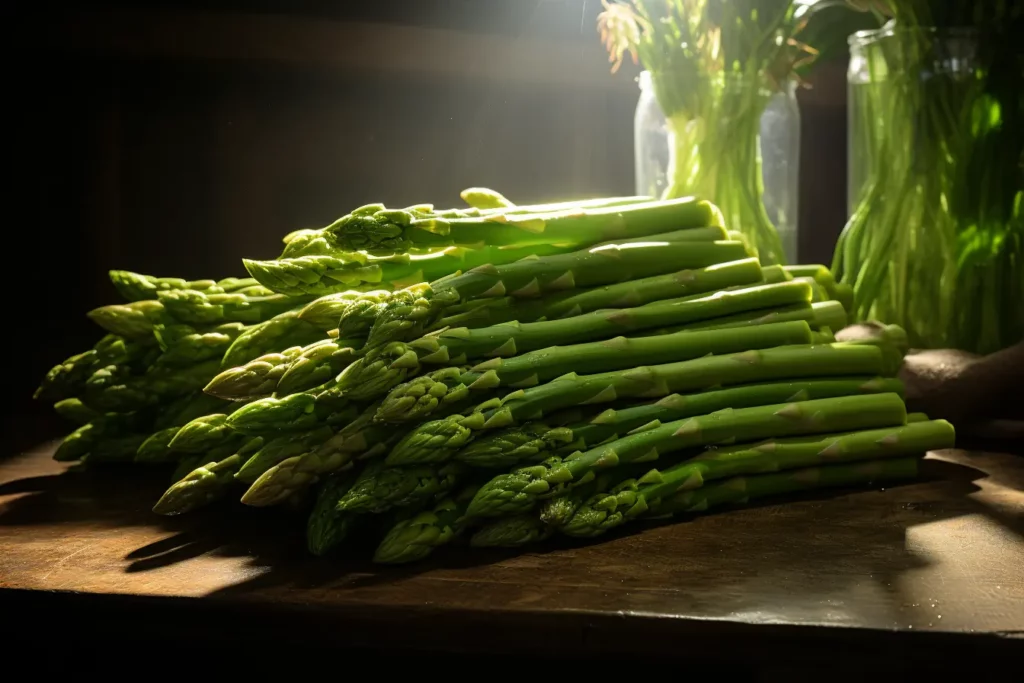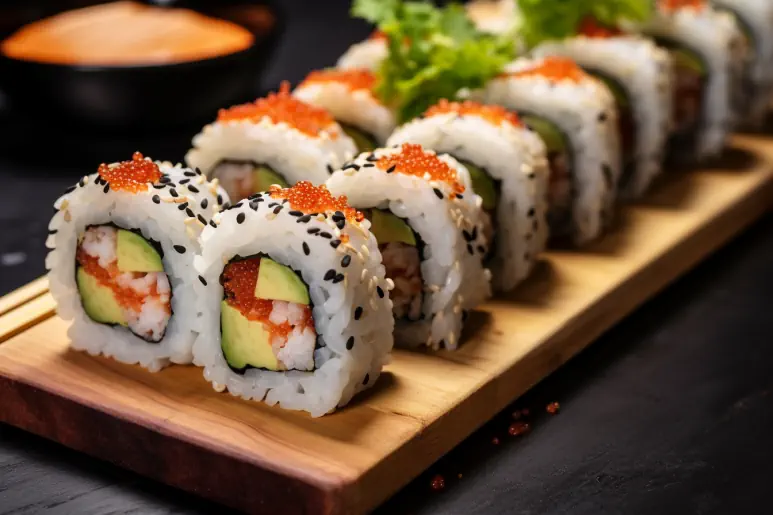Chopsticks are much more than just a handy tool for food intake. They are an important part of Japanese culture, ranging from historical development, rituals and etiquette to symbolic meaning. This article delves into the fascinating world of chopsticks, starting with their historical development, which shows how they became an essential tableware in Japanese culture. From there, we will shed light on the various rules and rituals associated with the use of chopsticks and show how deeply they are integrated into communal eating, festivities and ceremonies.
Historical development of chopsticks
To permeate food culture around the globe, it’s common to leave the comfort of forks and knives and instead see pairs of thin, polished wooden sticks, affectionately referred to as chopsticks. In countries like Japan, holding chopsticks is almost as natural as breathing—a skill that was instilled in early years. But how did these simple bamboo sticks find their way into all aspects of Japanese cuisine?
Chopsticks are believed to have originated in ancient China and eventually made their way to Japan. Historical evidence suggests that the Japanese made the cultural adoption of chopsticks around 800 AD. Originally, they were mainly used for religious ceremonies. It should be noted, however, that the consumption of raw fish – very peculiar to the Japanese – favored the use of chopsticks in the daily diet. Handling raw fish requires precise movements, and that’s where chopsticks come in.
Over time, chopsticks have evolved and become an integral part of Japanese food culture – reflecting not only cooking techniques, but also eating habits and social customs. Depending on the situation, different types of chopsticks can be used. The daily chopsticks are usually made of bamboo or wood, while lacquered or even gold and silver pairs are often used for special occasions.
Even today, Japan follows strict etiquette when it comes to the use of chopsticks. There are certain rules that are instilled in every Japanese person – such as how to hold the chopsticks or how to put them on the table. Ironically, in the Western world, it is often thought that the use of chopsticks is difficult, while for the Japanese it is a given.
Witnessing the changes in Japanese cooking and eating habits over the centuries, chopsticks reflect the deep culture and tradition that resonates in every piece of raw fish, bowl of rice, and steaming bowl of ramen. They are more than just a kitchen tool – they are a daily symbol of Japanese identity.

Rituals and etiquette with chopsticks
Boundless Fascination: Chopstick Rituals You Should Know
We have already talked about the remarkable journey of chopsticks from China to Japan, their use in Japanese cuisine, and their symbolic significance for Japanese identity and tradition. But now, let’s dive deeper into the impressive rituals and labels surrounding the use of chopsticks in Japan.
In Japanese culture, chopsticks do not only stand for simple cutlery, but are a reflection of social origins and upbringing. The correct handling of chopsticks is an art that is learned from an early age in Japan. In fact, the mere act of picking up a chopstick is an act that implies discipline, respect, and gratitude.
One such ritual is the adjustment of the chopsticks before eating. Before you start eating, take the chopsticks, tap them lightly on the edge of the table to remove any splinters that may be present, and then place them neatly next to each other. This shows respect for the food and those who prepared it.
Another deep-rooted ritual is the handing over of food with chopsticks. In Japan, one of the most basic taboos is to pass food directly from chopstick to chopstick, as it is reminiscent of a funeral ritual. Instead, it is recommended to put food on each other’s plates.
Similarly, sticking chopsticks vertically into rice is frowned upon, as this also indicates Buddhist burial ceremonies. The chopsticks should always be nicely placed next to each other on the chopstick rest or on the edge of the plate next to the food.
Finally, a little something about sauces. The Japanese tend to dip their food into the sauce rather carefully so that the chopsticks do not get dirty. To do this, part of the food is often dipped in the sauce instead of the whole bite.
These rituals and etiquettes are just a glimpse of Japan’s rich and diverse culture. Mastering this traditional craft is a sign of respect and admiration for the Japanese way of life. Understand and practice these customs to express your appreciation for this unique culture and to be a welcome guest in any traditional Japanese restaurant. It’s more than just cutlery, it’s an artful tradition.

Chopsticks in Modern Japanese Society
Chopsticks are the be-all and end-all of every Japanese dinner table. They are more than just simple cutlery, they are a reflection of the subtle, gestured etiquette and aesthetics that contribute significantly to the uniqueness of Japanese culture. Their significance extends beyond the purely practical application to the spiritual and symbolic.
The handling of chopsticks is considered not only a basic skill in Japan, but a true art. After all, they require skill, control and accuracy. To the outsider, it may be a painstakingly learned skill, but to the Japanese, it is a part of identity, tradition, and social life. Not only are they a tool for food intake, but they also strengthen social interaction and the expression of respect.
In Japan, certain rituals are part of the handling of chopsticks. Before eating, the chopsticks are neatly arranged, a silent but meaningful ritual that indicates both the upcoming culinary delight and the attitude and respect for the meal.
Also, there are a number of taboos related to chopsticks in Japan. A strong taboo is passing food from one pair of chopsticks to another. This is directly related to the Buddhist funeral rites and is therefore considered ominous. It is also considered out of place to stick chopsticks vertically into rice, as this is also reminiscent of grave rituals.
In a country where etiquette and tradition are extremely important, it is also important to use chopsticks correctly. This includes gently dipping food in sauces to keep the chopsticks clean. This is not only hygienic, but also reflects a fundamental pillar of Japanese life – respect and minimalism. Too much sauce would be considered disrespectful and wasteful.
In conclusion, chopsticks represent much more than just cutlery in Japanese society. They stand for respect, aesthetics, society and tradition. The correct handling of chopsticks is therefore an important element of Japanese culture and a sign of admiration and appreciation for the uniqueness of this fascinating society. They are a stylish yet indispensable element of the Japanese way of life and its rich, historical culture.

Symbolism and Meaning of Chopsticks in Japanese Culture
Beyond symbolic identity and tradition, chopsticks in Japanese culture are also an extension of the table setting, helping to create a soulful and flavorful harmony. They were originally introduced in China, but in Japan they have become an indispensable part of food culture. So much so that they are now unmistakably Japanese. The chopsticks become an aesthetic tool; a piece of hand-carved craft that adds to the pleasure of eating.
The behaviors and customs surrounding the use of chopsticks are extensive and complex. But each of these customs reflects the deep respect that the Japanese have for food and for the ritual that surrounds it. There is a special technique for placing the chopsticks on the tabletop – as if following an ancient ritual. This ritual is not only a symbol of cleanliness, but also a sign of respect for the food and those who prepared it.
In addition, there are some strictly followed taboos in Japan regarding chopsticks. One of the taboos is to pass food from chopstick to chopstick, as this is a tradition from funeral rites. Another taboo is to put chopsticks upright in a bowl of rice, as this is only done at a funeral ceremony.
The cleanliness of the chopsticks is also a high priority. Since dipping chopsticks directly into sauces is considered rude, the food should instead be carefully placed on the chopsticks and then dipped into the sauce. This shows an appreciation for aesthetics and care in the handling of food.
The correct use of chopsticks is considered an art form and is also a sign of personal discipline. It shows the ability to appreciate the little things in life and can be seen as part of the larger world of Japanese aesthetics that emphasizes the beauty of ordinary everyday objects.
Overall, chopsticks are much more than a simple tool for eating. They are symbols of aesthetics, respect, harmony and tradition. They reflect social etiquette and are a reflection of Japanese culture and identity. In Japanese culture, the sensitive use of chopsticks is not only a skill, but also a way of life. Therefore, it is good to understand that the meaning of chopsticks in Japanese culture goes far beyond the physical aspect. They are an integral part of Japanese culture and identity, representing values that are prevalent in every facet of their daily lives. It is this fine balance between function and form, between ritual and everyday life, that makes chopsticks uniquely Japanese.

Photo by thomaslohmann on Unsplash
Finally, this article introduces the deep symbolic meaning of chopsticks in Japanese culture. It reveals how this multi-layered symbolism is expressed in different cultural contexts, from religion and philosophy to art and literature. With their deep-rooted presence in people’s daily lives and consciousness, chopsticks form a fascinating window into Japanese culture, expanding our appreciation for their deeper layers of meaning and giving us a richer perspective on the different facets of Japanese life.


